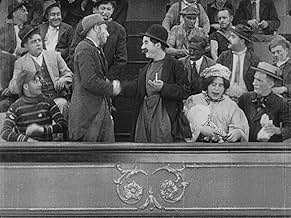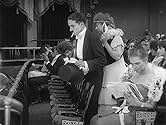Ajouter une intrigue dans votre langueMr. Pest tries several theatre seats before winding up in front in a fight with the conductor. He is thrown out. In the lobby he pushes a fat lady into a fountain and returns to sit down by ... Tout lireMr. Pest tries several theatre seats before winding up in front in a fight with the conductor. He is thrown out. In the lobby he pushes a fat lady into a fountain and returns to sit down by Edna. Mr. Rowdy, in the gallery, pours beer down on Mr. Pest and Edna. He attacks patrons,... Tout lireMr. Pest tries several theatre seats before winding up in front in a fight with the conductor. He is thrown out. In the lobby he pushes a fat lady into a fountain and returns to sit down by Edna. Mr. Rowdy, in the gallery, pours beer down on Mr. Pest and Edna. He attacks patrons, a harem dancer, the singers Dot and Dash, and a fire-eater.
- Réalisation
- Scénario
- Casting principal
- Lady in Audience
- (non crédité)
- Man in Balcony
- (non crédité)
- Ticket Taker
- (non crédité)
- …
- Man Behind Bead Lady
- (non crédité)
- First in Line
- (non crédité)
- …
- Gentleman in Audience
- (non crédité)
- Tuba Player
- (non crédité)
- Member of 'Dot and Dash'
- (non crédité)
- …
- Trombone Player and Singer
- (non crédité)
- …
- Large Boy
- (non crédité)
- Feather Duster
- (non crédité)
- …
- Lady in the Stalls
- (non crédité)
- Lady in the Stalls with Beads
- (non crédité)
- Orchestra Conductor
- (non crédité)
- Tootsy Frutti the snake charmer
- (non crédité)
- Second Man in Balcony Front Row
- (non crédité)
Avis à la une
Mr. Rowdy (Chaplin) is an abusive drunk with an overblown mischievous streak. We learn little about him, and he's there for the laughs he provides. He does provide them, and one can imagine that he was just a fun character to play.
Mr. Pest (Chaplin), on the other hand, has the universe revolving around him. Everyone else in the theater is there for his amusement, and it strained credulity a little bit which is fine that he wasn't just thrown out of the place.
The show which Chaplin attends is intolerable until Chaplin takes matters into his own hands. Some people in the audience, you'll feel, deserve to be smacked, and of course, they are knocked around by a master.
I'm a big fan of his Keystone stuff, but "A Night at the Show" is Chaplin freed at Essanay. The world is his oyster, and he sups on seafood. It's a blast!
During the first part, there are some misadventures as Charlie's characters settle into their seats, with one of his characters being the kind of chronic seat-changer that we've all had to deal with. During the second part, the show begins, and the audience and the various performers compete with each other for attention.
Chaplin used a lot of comic ideas in this one, some slapstick and some more subtle. It is also very interesting as a look (though probably exaggerated) at the kind of often off-beat live entertainment that was so popular in the days before television and radio.
This is an interesting short, and worth a look.
Appropriately enough, this is also a rare outing for Chaplin's aristocratic drunk act, which predates his little tramp, having originated in his days with the Karno troupe. While not as versatile or sympathetic as the tramp, the drunk could nevertheless be just as funny. With Chaplin's refined directorial style, he makes the most of the character's antics, allowing him to bumble about in a series of long takes. He is joined by "Mr Rowdy", also played by Chaplin, a character I have not seen anywhere else, but who bares a slight resemblance to the screen persona of Ben Turpin, who made a few appearances for Chaplin in earlier Essanay shorts. Mr Rowdy isn't exactly hilarious, although he allows for some interplay between the two Chaplins, as we see the drink Rowdy pours from the gallery landing on the drunk in the stalls in two separate shots, which is a kind of cinematic joke in itself – and one thing Chaplin couldn't have done on stage.
In fact, this whole piece seems to be Chaplin showing off the advantages of screen over stage. Although in the Karno sketch the drunk would be planted in the audience, right by the stage as we see him here, it did not involve the audience any further. In the medium of film, Chaplin can make as many gags as he wants among the on screen audience. In the most bizarre bit of nose-thumbing, there is even a Georges Melies moment, when the demonic fire-eater "appears" on stage with a stop-trick. It is, in many ways, one of the most intelligent shorts Chaplin made at Essanay. And yet, sadly it isn't very funny. It doesn't have the sense of cohesion or build up of gags that we would expect from a Chaplin short by this point.
But there's still time for the all-important statistic - Number of kicks up the arse: 1 (1 for)
From his Essanay period after leaving Keystone, 'A Night in the Show' (from my understanding it is indeed based on his vaudeville years with Fred Karno) is not one of his very best but is one of his best early efforts and among the better short films of his. It shows a noticeable step up in quality though from his Keystone period, where he was still evolving and in the infancy of his long career, from 1914, The Essanay period is something of Chaplin's adolescence period where his style had been found and starting to settle. Something that can be seen in the more than worthwhile 'The Bank'.
The story is still flimsy and actually one of the most lightweight ones of the Essanay period, there are times where it struggles to sustain the short length, and could have had more variety.
On the other hand, 'A Night in the Show' looks pretty good, not incredible but it was obvious that Chaplin was taking more time with his work and not churning out countless shorts in the same year of very variable success like he did with Keystone. Appreciate the importance of his Keystone period and there is some good stuff he did there, but the more mature and careful quality seen here and later on is obvious.
While not one of his most hilarious or touching, 'A Night in the Show' is still very funny with some clever, entertaining and well-timed slapstick and is one of his first to have substance and pathos after 'The Bank' and 'The Tramp'. It moves quickly and there is no dullness in sight. The ending is great fun.
Chaplin directs more than competently, if not quite cinematic genius standard yet. He also, as usual, gives an amusing and expressive performance and at clear ease with the physicality and substance of the role. The supporting cast acquit themselves well.
In summary, very good and one of the best from Chaplin's Essanay period. 8/10 Bethany Cox
This is one of the few of these early films that could withstand repeated watching of it.
Le saviez-vous
- AnecdotesBased on a famous comedy act called "Mummingbirds" in which Charles Chaplin starred when he was a player with The Karno Company in England.
- GaffesWhen the snake charmer is near Mr Rowdy, you can see she is barefoot. But, a shot after, she is wearing low heeled boots.
- Citations
Title Card: La Belle Wienerwurst.
- ConnexionsEdited into Chaplin's Art of Comedy (1966)
Meilleurs choix
Détails
- Date de sortie
- Pays d’origine
- Site officiel
- Langues
- Aussi connu sous le nom de
- Charlot au spectacle
- Société de production
- Voir plus de crédits d'entreprise sur IMDbPro
- Durée24 minutes
- Couleur
- Mixage
- Rapport de forme
- 1.33 : 1
Contribuer à cette page

































